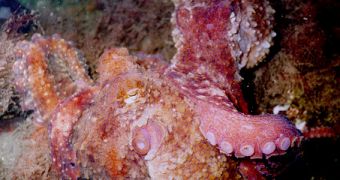Octopuses may be the brains of the sea, but not the sea lovers. They really give a new perspective to the phrase "the male is just a tab of the penis." A new study made at the University of California, Berkeley, and published in the journal "Marine Biology," shows that at least one species of octopus inhabiting the shallow reef waters off northern Sulawesi Island (Indonesia) has a complex and passionate sexual behavior.
The species Abdopus aculeatus is a diurnal small octopus, with a spiky tan body the size of an apple and 8-to-10-in (20-25 cm) long arms. "This is not a unique species of octopus, which suggests others behave this way," said co-author Roy Caldwell, a professor of integrative biology at UC Berkeley.
The Abdopus males appeared to be choosy and when they selected a specific sex partner, they jealously guarded her den for several days, chasing away rivals and even engaging in strangling them when they ignored the warnings. Males appeared to prefer large females.
"If you're going to spend time guarding a female, you want to go for the biggest female you can find because she's going to produce more eggs. Most of what we know about octopuses comes from laboratory observations of just a few species," said Caldwell.
Flirting or fighting males signaled their gender through striped body patterns (octopuses have mimic ability overcoming that of a chameleon; one individual has 1-2 million chromatophores in its skin, starred pigment cells colored in yellow, orange, red, brown or black, and activated through nerves).
The team also detected small "sneaker" males attempting to mate with females while hiding their male identity, by mimicking female type of swimming and not showing the masculine brown stripes.
The shyness of the octopuses makes them hard to investigate in the lab, especially their mating rituals.
"They're obsessively secretive, solitary and pretty spooky. If you watch them, they watch you back," said Caldwell.
"We quickly realized that Abdopus aculeatus broke all the 'rules' - doing the near opposite of every hypothesis we'd formed based on aquarium studies," said lead author Christine Huffard, a Berkeley graduate and postdoctoral fellow at the Monterey Bay Aquarium Research Institute in Moss Landing, California, who investigated the population of northern Sulawesi Abdopus aculeatus for her Ph.D. fieldwork.
In other octopus species
There are 289 species of octopuses, ranging from the giant octopus in the Northern Pacific (Octopus dofleini), which has on average 3 m (10 ft) in length and weighs 15 kg (33.3 pounds) (but the record was of 10 m (30 ft) in length and 272 kg (604 pounds)) to the male argonaut octopuses that are 2 cm (0.8 inch) long.
Octopuses live only 1-3 years in the case of females and up to 5 years in the case of males. They mate (at least females) just once for several times when they reach sexual maturity.
The penis of the octopus is called hectocotylus and it is formed of the third tentacle on the right of the male, which is modified in various ways to effect the fertilization of the female's eggs. It stores spermatophores (packages of sperm cells). After one mating, when the male loses its hectocotylus, it won't be able to copulate again till the next season, when a new hectocotylus grows.
In common type octopuses, males die within few months after mating, without regenerating another hectocotylus. The shape and size of the hectocotylus varies greatly among octopus species, being used for species identification.
Usually, the internal side is almost devoid of cups and irregularly creased. In many species, it is considerably elaborated. Sometimes, the hectocotylus can even lose its tentacle form, and the males of those species have the appearance of having only seven tentacles.
Mating can last for two hours and the male introduces the hectocotylus into the gills' cavity where it deposes the spermatophores (pouches filled with millions of sperm cells), but the partners keep the distance. They recognize each other through smell and touch. During the mating, the male loses its hectocotylus, but till the next season, he will regenerate a new one.
In Argonauta octopuses, the male does not even approach the female. When the spermatophores are formed, the hectocotylus breaks off from the male while away from the female, heading towards her and entering alone into its mantle cavity. The funnel-mantle locking apparatus on the hectocotylus keeps it lodged inside the cavity.
The female octopuses lay strings of eggs (comprising 100-500,000 eggs) attached to the roof of an underwater dwelling or cave. She fasts until the eggs hatch (24 to 125 days later), guarding them and oxygenating them via blown water jets. Then, she dies. "Most of what we know about octopuses comes from laboratory observations of just a few species," said Caldwell.
"This is the first study to show a level of sophistication not previously known in the sexual behavior of an octopus," added Caldwell.

 14 DAY TRIAL //
14 DAY TRIAL //